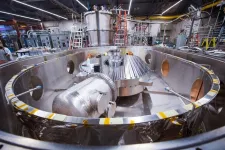In the predawn hours of Sept. 5, 2021, engineers achieved a major milestone in the labs of MIT’s Plasma Science and Fusion Center (PSFC), when a new type of magnet, made from high-temperature superconducting material, achieved a world-record magnetic field strength of 20 tesla for a large-scale magnet. That’s the intensity needed to build a fusion power plant that is expected to produce a net output of power and potentially usher in an era of virtually limitless power production.
The test was immediately declared a success, having met all the criteria established for the design of the new fusion device, dubbed SPARC, for which the magnets are the key enabling technology. Champagne corks popped as the weary team of experimenters, who had labored long and hard to make the achievement possible, celebrated their accomplishment.
But that was far from the end of the process. Over the ensuing months, the team tore apart and inspected the components of the magnet, pored over and analyzed the data from hundreds of instruments that recorded details of the tests, and performed two additional test runs on the same magnet, ultimately pushing it to its breaking point in order to learn the details of any possible failure modes.
All of this work has now culminated in a detailed report by researchers at PSFC and MIT spinout company Commonwealth Fusion Systems (CFS), published in a collection of six peer-reviewed papers in a special edition of the March issue of IEEE Transactions on Applied Superconductivity. Together, the papers describe the design and fabrication of the magnet and the diagnostic equipment needed to evaluate its performance, as well as the lessons learned from the process. Overall, the team found, the predictions and computer modeling were spot-on, verifying that the magnet’s unique design elements could serve as the foundation for a fusion power plant.
Enabling practical fusion power
The successful test of the magnet, says Hitachi America Professor of Engineering Dennis Whyte, who recently stepped down as director of the PSFC, was “the most important thing, in my opinion, in the last 30 years of fusion research.”
Before the Sept. 5 demonstration, the best-available superconducting magnets were powerful enough to potentially achieve fusion energy — but only at sizes and costs that could never be practical or economically viable. Then, when the tests showed the practicality of such a strong magnet at a greatly reduced size, “overnight, it basically changed the cost per watt of a fusion reactor by a factor of almost 40 in one day,” Whyte says.
“Now fusion has a chance,” Whyte adds. Tokamaks, the most widely used design for experimental fusion devices, “have a chance, in my opinion, of being economical because you’ve got a quantum change in your ability, with the known confinement physics rules, about being able to greatly reduce the size and the cost of objects that would make fusion possible.”
The comprehensive data and analysis from the PSFC’s magnet test, as detailed in the six new papers, has demonstrated that plans for a new generation of fusion devices — the one designed by MIT and CFS, as well as similar designs by other commercial fusion companies — are built on a solid foundation in science.
The superconducting breakthrough
Fusion, the process of combining light atoms to form heavier ones, powers the sun and stars, but harnessing that process on Earth has proved to be a daunting challenge, with decades of hard work and many billions of dollars spent on experimental devices. The long-sought, but never yet achieved, goal is to build a fusion power plant that produces more energy than it consumes. Such a power plant could produce electricity without emitting greenhouse gases during operation, and generating very little radioactive waste. Fusion’s fuel, a form of hydrogen that can be derived from seawater, is virtually limitless.
But to make it work requires compressing the fuel at extraordinarily high temperatures and pressures, and since no known material could withstand such temperatures, the fuel must be held in place by extremely powerful magnetic fields. Producing such strong fields requires superconducting magnets, but all previous fusion magnets have been made with a superconducting material that requires frigid temperatures of about 4 degrees above absolute zero (4 kelvins, or -270 degrees Celsius). In the last few years, a newer material nicknamed REBCO, for rare-earth barium copper oxide, was added to fusion magnets, and allows them to operate at 20 kelvins, a temperature that despite being only 16 kelvins warmer, brings significant advantages in terms of material properties and practical engineering.
Taking advantage of this new higher-temperature superconducting material was not just a matter of substituting it in existing magnet designs. Instead, “it was a rework from the ground up of almost all the principles that you use to build superconducting magnets,” Whyte says. The new REBCO material is “extraordinarily different than the previous generation of superconductors. You’re not just going to adapt and replace, you’re actually going to innovate from the ground up.” The new papers in Transactions on Applied Superconductivity describe the details of that redesign process, now that patent protection is in place.
A key innovation: no insulation
One of the dramatic innovations, which had many others in the field skeptical of its chances of success, was the elimination of insulation around the thin, flat ribbons of superconducting tape that formed the magnet. Like virtually all electrical wires, conventional superconducting magnets are fully protected by insulating material to prevent short-circuits between the wires. But in the new magnet, the tape was left completely bare; the engineers relied on REBCO’s much greater conductivity to keep the current flowing through the material.
“When we started this project, in let’s say 2018, the technology of using high-temperature superconductors to build large-scale high-field magnets was in its infancy,” says Zach Hartwig, the Robert N. Noyce Career Development Professor in the Department of Nuclear Science and Engineering. Hartwig has a co-appointment at the PSFC and is the head of its engineering group, which led the magnet development project. “The state of the art was small benchtop experiments, not really representative of what it takes to build a full-size thing. Our magnet development project started at benchtop scale and ended up at full scale in a short amount of time,” he adds, noting that the team built a 20,000-pound magnet that produced a steady, even magnetic field of just over 20 tesla — far beyond any such field ever produced at large scale.
“The standard way to build these magnets is you would wind the conductor and you have insulation between the windings, and you need insulation to deal with the high voltages that are generated during off-normal events such as a shutdown.” Eliminating the layers of insulation, he says, “has the advantage of being a low-voltage system. It greatly simplifies the fabrication processes and schedule.” It also leaves more room for other elements, such as more cooling or more structure for strength.
The magnet assembly is a slightly smaller-scale version of the ones that will form the donut-shaped chamber of the SPARC fusion device now being built by CFS in Devens, Massachusetts. It consists of 16 plates, called pancakes, each bearing a spiral winding of the superconducting tape on one side and cooling channels for helium gas on the other.
But the no-insulation design was considered risky, and a lot was riding on the test program. “This was the first magnet at any sufficient scale that really probed what is involved in designing and building and testing a magnet with this so-called no-insulation no-twist technology,” Hartwig says. “It was very much a surprise to the community when we announced that it was a no-insulation coil.”
Pushing to the limit … and beyond
The initial test, described in previous papers, proved that the design and manufacturing process not only worked but was highly stable — something that some researchers had doubted. The next two test runs, also performed in late 2021, then pushed the device to the limit by deliberately creating unstable conditions, including a complete shutoff of incoming power that can lead to a catastrophic overheating. Known as quenching, this is considered a worst-case scenario for the operation of such magnets, with the potential to destroy the equipment.
Part of the mission of the test program, Hartwig says, was “to actually go off and intentionally quench a full-scale magnet, so that we can get the critical data at the right scale and the right conditions to advance the science, to validate the design codes, and then to take the magnet apart and see what went wrong, why did it go wrong, and how do we take the next iteration toward fixing that. … It was a very successful test.”
That final test, which ended with the melting of one corner of one of the 16 pancakes, produced a wealth of new information, Hartwig says. For one thing, they had been using several different computational models to design and predict the performance of various aspects of the magnet’s performance, and for the most part, the models agreed in their overall predictions and were well-validated by the series of tests and real-world measurements. But in predicting the effect of the quench, the model predictions diverged, so it was necessary to get the experimental data to evaluate the models’ validity.
“The highest-fidelity models that we had predicted almost exactly how the magnet would warm up, to what degree it would warm up as it started to quench, and where would the resulting damage to the magnet would be,” he says. As described in detail in one of the new reports, “That test actually told us exactly the physics that was going on, and it told us which models were useful going forward and which to leave by the wayside because they’re not right.”
Whyte says, “Basically we did the worst thing possible to a coil, on purpose, after we had tested all other aspects of the coil performance. And we found that most of the coil survived with no damage,” while one isolated area sustained some melting. “It’s like a few percent of the volume of the coil that got damaged.” And that led to revisions in the design that are expected to prevent such damage in the actual fusion device magnets, even under the most extreme conditions.
Hartwig emphasizes that a major reason the team was able to accomplish such a radical new record-setting magnet design, and get it right the very first time and on a breakneck schedule, was thanks to the deep level of knowledge, expertise, and equipment accumulated over decades of operation of the Alcator C-Mod tokamak, the Francis Bitter Magnet Laboratory, and other work carried out at PSFC. “This goes to the heart of the institutional capabilities of a place like this,” he says. “We had the capability, the infrastructure, and the space and the people to do these things under one roof.”
The collaboration with CFS was also key, he says, with MIT and CFS combining the most powerful aspects of an academic institution and private company to do things together that neither could have done on their own. “For example, one of the major contributions from CFS was leveraging the power of a private company to establish and scale up a supply chain at an unprecedented level and timeline for the most critical material in the project: 300 kilometers (186 miles) of high-temperature superconductor, which was procured with rigorous quality control in under a year, and integrated on schedule into the magnet.”
The integration of the two teams, those from MIT and those from CFS, also was crucial to the success, he says. “We thought of ourselves as one team, and that made it possible to do what we did.”
Written by David L. Chandler, MIT News Office
Papers: Special issue on the SPARC Toroidal Field Model Coil Program
https://ieeexplore.ieee.org/xpl/tocresult.jsp?isnumber=10348035&punumber=77
END











